Key takeaways:
- Selective mutism is a complex anxiety disorder, not merely shyness, and requires empathy for those affected.
- Patience is essential in communication; allowing silence can foster connections and understanding.
- Raising awareness through education and personal stories can help break the stigma surrounding selective mutism.
- Creating supportive environments and focusing on non-verbal communication can enhance interactions with individuals experiencing selective mutism.
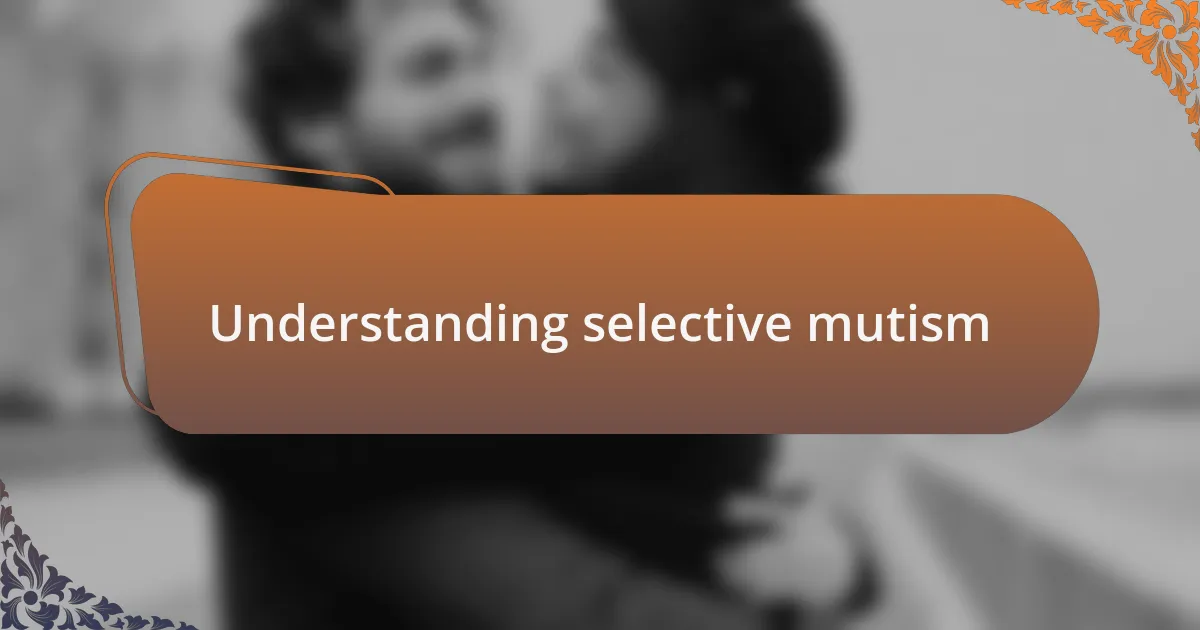
Understanding selective mutism
Selective mutism is more than just a reluctance to speak; it’s a complex anxiety disorder often seen in children. I once watched a close friend’s daughter struggle in social settings, her silence not stemming from unwillingness but from an overwhelming fear that gripped her. It made me wonder, what profound emotions must be swirling within her when the world outside feels so daunting?
Many people assume that selective mutism means a child simply chooses not to talk, but that couldn’t be further from the truth. I remember the first time I spoke to a child with selective mutism, and her eyes danced with a mix of fear and longing. She clearly wanted to join the conversation, but the words simply wouldn’t come out. Isn’t it eye-opening how this condition highlights the power of communication in our lives and the barriers that can sometimes inhibit it?
The condition often leads to misunderstandings, as friends and family may mistakenly label these children as shy or rude. I’ve seen how these misconceptions can hurt, leaving the child feeling even more isolated. When we begin to understand selective mutism as an anxiety-driven response, it beckons us to approach those affected with empathy rather than judgment. Don’t you think this shift in perception could truly change the way we support these children?
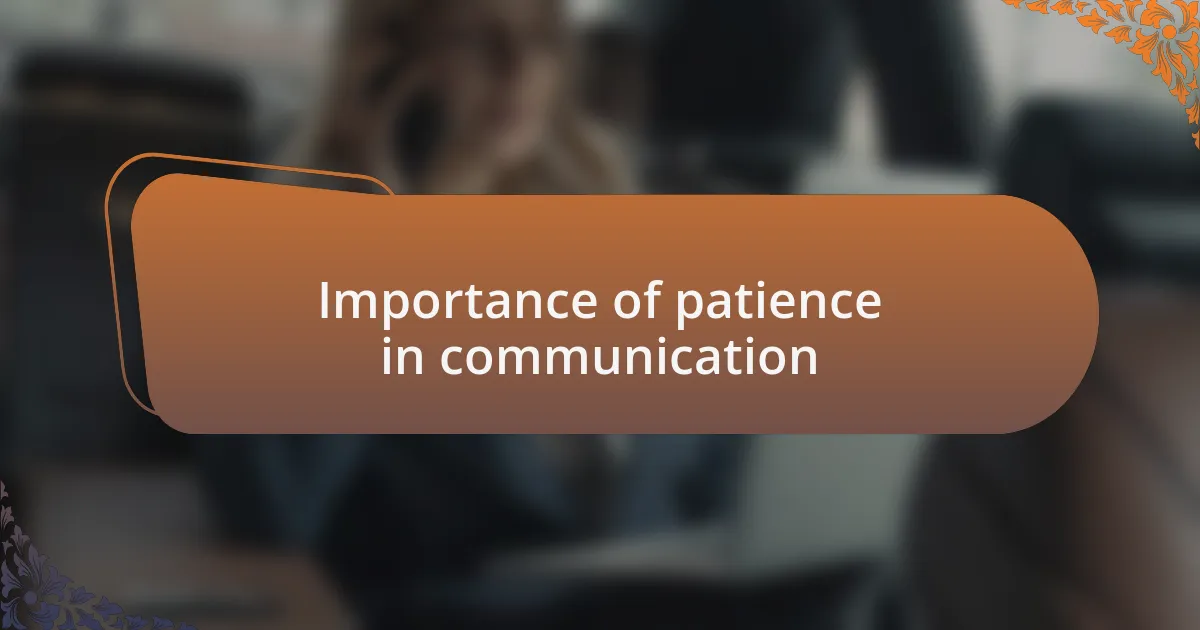
Importance of patience in communication
Patience is a cornerstone of effective communication, especially when engaging with someone experiencing selective mutism. I recall a group therapy session where, despite the charged atmosphere, the silence felt oddly comforting. The facilitator took her time, allowing moments of quiet for each child to process their thoughts, and I realized that these pauses created a safe space for them to eventually express themselves.
In my experience, it’s fascinating how patience can transform interactions. I once chatted with a boy who struggled to find his voice. Rather than pressuring him, I found myself simply sitting with him, sharing stories and drawing in the sand. Those quiet moments of being present allowed him to relax; eventually, he began to speak up, showcasing the magic that patience can weave into communication.
It’s crucial to remember that our eagerness to fill in the silence can unintentionally undermine the very connection we seek. Have you ever noticed how rushing a conversation can lead to misunderstandings? By allowing for pauses and respecting the time it takes for someone to respond, we not only validate their feelings but also foster a deeper understanding, creating a bridge that encourages open dialogue.
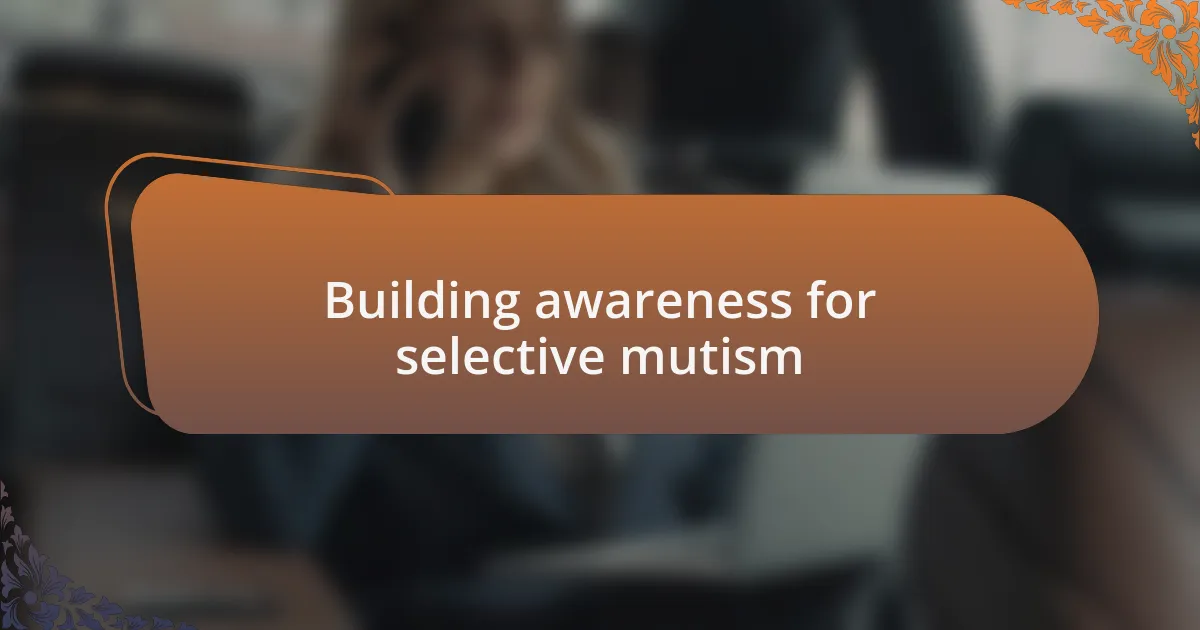
Building awareness for selective mutism
Building awareness for selective mutism requires empathy and understanding from everyone involved. I remember attending a community event where a parent shared their struggles with a child who rarely spoke. It struck me how many people offered support and resources, but what resonated most was the assurance that simply being present makes a difference. Couldn’t we all use a little more patience in our interactions, especially with those who find it hard to communicate?
One effective way to raise awareness is through education in schools and community programs. I often reflect on a workshop I organized where we role-played scenarios to illustrate the challenges faced by those with selective mutism. Seeing the participants’ faces as they began to grasp the anxiety these children feel reinforced the significance of adapting our approach. How can we foster an environment where silence is not only accepted but understood?
Moreover, sharing personal stories plays a vital role in breaking the stigma surrounding selective mutism. On social media, I’ve seen parents bravely share their journeys, capturing both the struggles and victories. Each story not only raises awareness but also fosters a sense of community, reminding us that no one is alone in this journey. Isn’t it empowering to know that by simply sharing our experiences, we can inspire change and understanding in others?
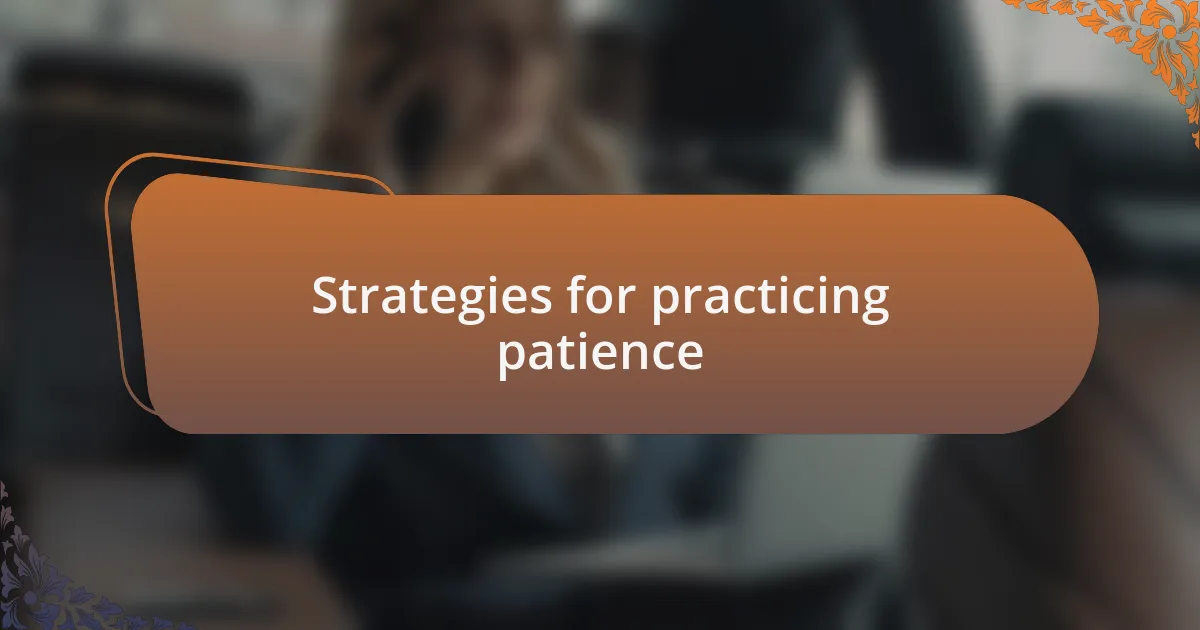
Strategies for practicing patience
Practicing patience can be a subtle art, but incorporating simple strategies can make a significant difference. For instance, I once committed to a daily mindfulness practice, setting aside just five minutes to breathe and reflect. This small investment in time redefined how I approached interactions, allowing me to engage with others more openly, even when words were in short supply. Have you ever tried just listening without a need to respond? It’s freeing.
Another strategy that proved valuable for me was setting realistic expectations. I remember volunteering with a child who faced challenges with verbal communication. At first, I wanted immediate engagement, but I soon learned that celebrating small steps, like a nod or a smile, was crucial. Each little sign of connection encouraged patience in both of us. What if we started to focus on progress rather than perfection?
Lastly, creating an environment of calm can foster patience for everyone involved. Once, during a family gathering, I noticed the atmosphere was tense, especially for my cousin with selective mutism. I suggested we play a quiet game that didn’t require speaking. It transformed the space into one where everyone felt comfortable, reinforcing the idea that patience flourishes in a supportive environment. How could simple adjustments in our surroundings lead to deeper connections?
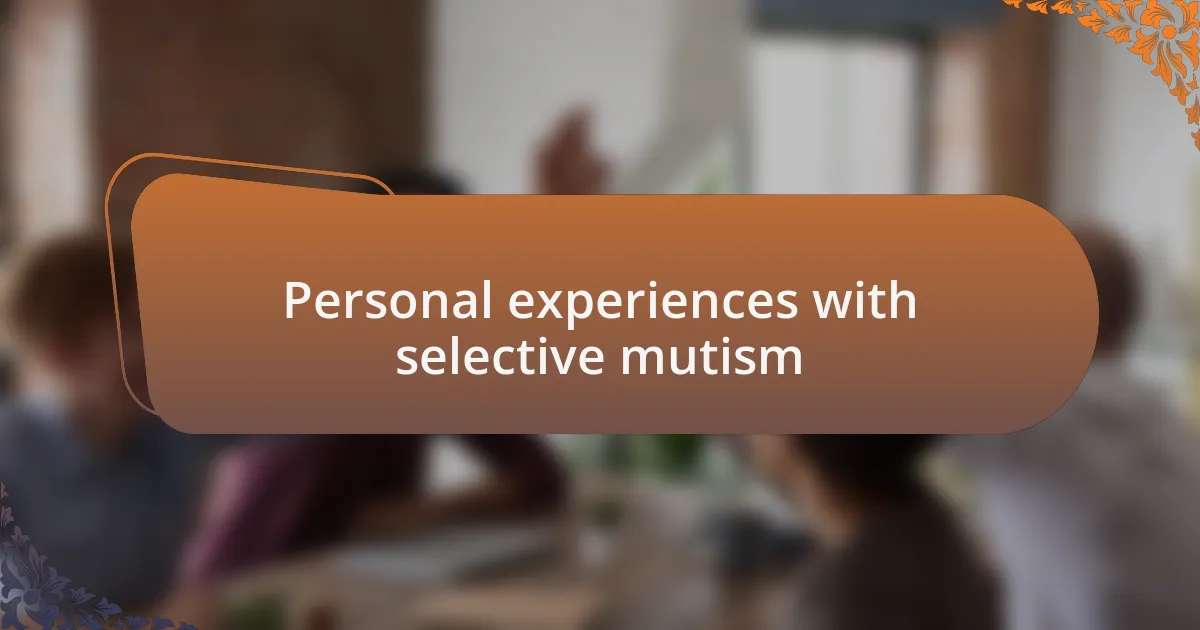
Personal experiences with selective mutism
When I first learned about selective mutism, I felt a mix of empathy and confusion. I recall one time with a friend who struggled to speak in large groups. While we were in a crowded café, her silence spoke volumes. I could see the anxiety in her eyes, which made me realize the importance of silent support. Have you ever noticed how sometimes just being present can convey more than words?
I still remember my first encounter with a child who had selective mutism during a school visit. I expected to engage through conversation, but I quickly learned that his hesitation to speak didn’t mean he was uninterested. As I sat beside him, we drew together in silence, sharing moments of creativity instead. It was enlightening to discover how art could bridge the gap, and it taught me that patience often reveals unexpected pathways. How often do we miss connections because we overlook non-verbal communication?
Reflecting on my journey, I’ve come to appreciate the layers of emotions tied to selective mutism. There was a moment when I accidentally spoke for someone else in a group, only to see their face fall. That realization struck me deeply. I learned that fulfilling the need for patience goes beyond waiting; it’s about creating space for someone to express themselves in their own time. When have you felt the pressure to fill silence, and how might it help to step back instead?
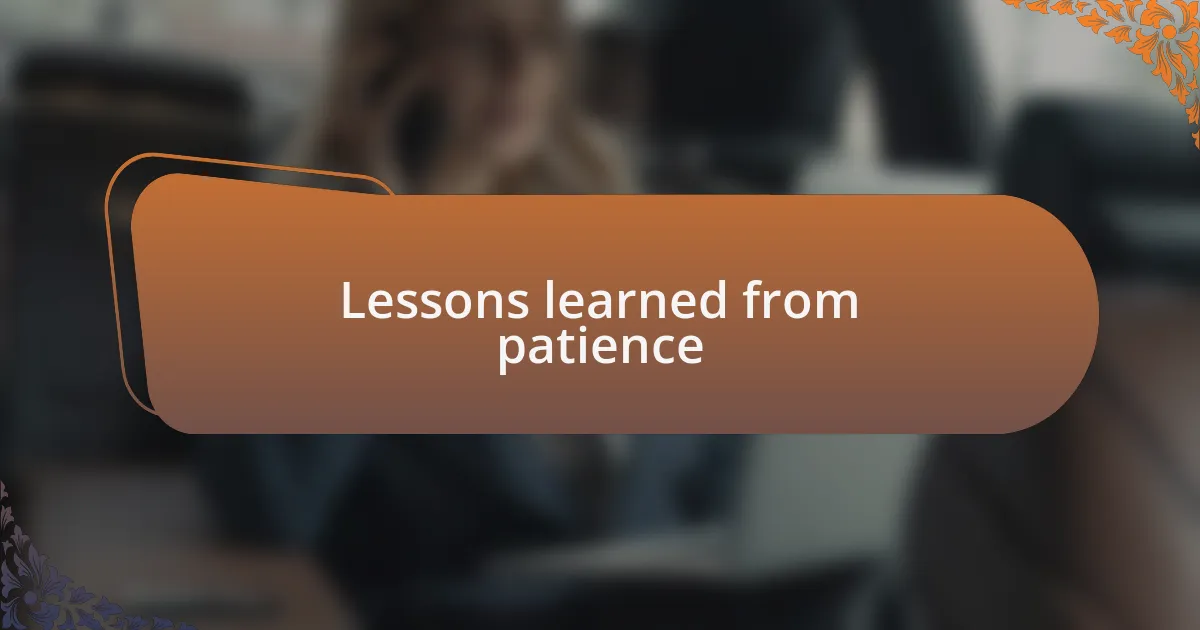
Lessons learned from patience
While navigating my own journey with patience, I’ve discovered that it often requires deep listening. I recall attending a workshop where a participant shared her struggles with selective mutism. In listening to her story, I felt a sense of connection that transcended words, highlighting that sometimes, the most impactful lessons come from silence. Have you ever found yourself understanding someone better in moments of quiet reflection?
One particular experience stands out: volunteering at a community event where kids with selective mutism were encouraged to express themselves artistically. I was astounded by how a simple paintbrush could evoke emotions that words couldn’t capture. Witnessing their creativity unfold in silence taught me a valuable lesson: patience is not just about waiting; it’s about nurturing an environment where people can feel safe to express what they might otherwise keep inside. What does it mean to you to create that safe space for others?
Over time, I’ve learned that patience often means embracing discomfort. During a particularly tense family gathering, I found myself caught in a cycle of trying to coax a shy relative into conversation. It hit me then that my eagerness was creating pressure rather than comfort. In that moment, I chose to remain quiet, allowing her to engage on her terms. The lesson? Sometimes, the greatest gift we can give is simply our presence without the need to fill the silence. How might your own experiences with silence encourage deeper understanding and connection?
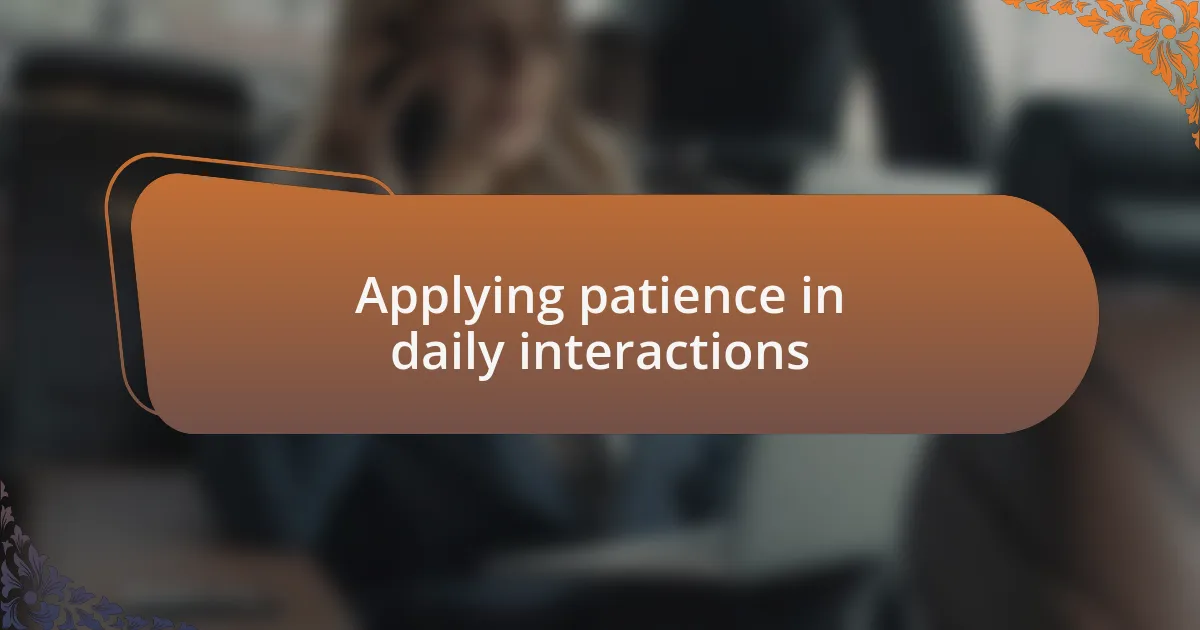
Applying patience in daily interactions
Daily interactions are a dance where patience plays a crucial role. I recall a morning at the coffee shop when I noticed a child struggling to place an order due to their selective mutism. Instead of rushing in to help, I chose to wait and observe, allowing them to take their time. In that moment, witnessing the determination on their face made me realize the power of giving someone the space they need to navigate their own challenges.
I often find myself reflecting on conversations within my family, where patience can sometimes feel like a rare commodity. There was a time when I tried to prompt a quiet cousin to share her thoughts during dinner. Instead of barreling ahead with questions, I decided to pause and let the conversation breathe. The silence that followed felt heavy at first, but gradually, she opened up on her own time, sharing insights that surprised all of us. Isn’t it fascinating how a little patience can unlock deeper connections?
There’s also the beauty of patience in unexpected moments, like in a public park where I once sat beside a friend who struggled with voicing her opinions. I remember feeling the urge to fill the quiet, but instead, I remained present, allowing her the time she needed to articulate her thoughts. When she finally spoke, her words were not just profound; they were a reminder that patience is an invisible thread that weaves sincerity and understanding into every interaction we have. How often do we let that thread guide us in our daily lives?